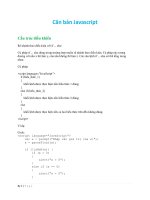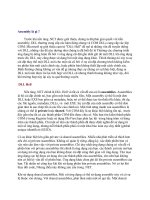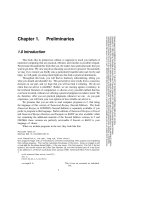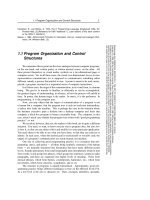Tài liệu Preliminaries part 2 doc
Bạn đang xem bản rút gọn của tài liệu. Xem và tải ngay bản đầy đủ của tài liệu tại đây (133.25 KB, 11 trang )
1.1 Program Organization and Control Structures
5
Sample page from NUMERICAL RECIPES IN C: THE ART OF SCIENTIFIC COMPUTING (ISBN 0-521-43108-5)
Copyright (C) 1988-1992 by Cambridge University Press.Programs Copyright (C) 1988-1992 by Numerical Recipes Software.
Permission is granted for internet users to make one paper copy for their own personal use. Further reproduction, or any copying of machine-
readable files (including this one) to any servercomputer, is strictly prohibited. To order Numerical Recipes books,diskettes, or CDROMs
visit website or call 1-800-872-7423 (North America only),or send email to (outside North America).
Kernighan, B., and Ritchie, D. 1978,
The C Programming Language
(Englewood Cliffs, NJ:
Prentice-Hall). [2] [Reference for K&R “traditional” C. Later editions of this book conform
to the ANSI C standard.]
Meeus, J. 1982,
Astronomical Formulae for Calculators
, 2nd ed., revised and enlarged (Rich-
mond, VA: Willmann-Bell). [3]
1.1 Program Organization and Control
Structures
We sometimes liketo point out theclose analogies betweencomputer programs,
on the one hand, and written poetry or written musical scores, on the other. All
three present themselves as visual media, symbols on a two-dimensional page or
computer screen. Yet, in all three cases, the visual, two-dimensional, frozen-in-time
representation communicates (or is supposed to communicate) something rather
different, namely a process that unfolds in time. A poem is meant to be read; music,
played; a program, executed as a sequential series of computer instructions.
In all three cases, the target of the communication, in its visual form, is a human
being. The goal is to transfer to him/her, as efficiently as can be accomplished,
the greatest degree of understanding, in advance, of how the process will unfold in
time. In poetry, this human target is the reader. In music, it is the performer. In
programming, it is the program user.
Now, you may object that the target of communication of a program is not
a human but a computer, that the program user is only an irrelevant intermediary,
a lackey who feeds the machine. This is perhaps the case in the situation where
the business executive pops a diskette into a desktop computer and feeds that
computer a black-box program in binary executable form. The computer, in this
case, doesn’t much care whether that program was written with “good programming
practice” or not.
We envision, however, that you, the readers of this book, are in quite a different
situation. You need, or want, to know not just what a program does, but also how
it does it, so that you can tinker with it and modify it to your particular application.
You need others to be able to see what you have done, so that they can criticize or
admire. In such cases, where the desired goal is maintainable or reusable code, the
targets of a program’s communication are surely human, not machine.
One key to achieving good programming practice is to recognize that pro-
gramming, music, and poetry — all three being symbolic constructs of the human
brain — are naturally structured into hierarchies that have many different nested
levels. Sounds (phonemes) form small meaningful units (morphemes) which in turn
form words; words group into phrases, which group into sentences; sentences make
paragraphs, and these are organized into higher levels of meaning. Notes form
musical phrases, which form themes, counterpoints, harmonies, etc.; which form
movements, which form concertos, symphonies, and so on.
The structure in programs is equally hierarchical. Appropriately, good pro-
gramming practice brings different techniques to bear on the different levels
[1-3]
.
At a low level is the ascii character set. Then, constants, identifiers, operands,
6
Chapter 1. Preliminaries
Sample page from NUMERICAL RECIPES IN C: THE ART OF SCIENTIFIC COMPUTING (ISBN 0-521-43108-5)
Copyright (C) 1988-1992 by Cambridge University Press.Programs Copyright (C) 1988-1992 by Numerical Recipes Software.
Permission is granted for internet users to make one paper copy for their own personal use. Further reproduction, or any copying of machine-
readable files (including this one) to any servercomputer, is strictly prohibited. To order Numerical Recipes books,diskettes, or CDROMs
visit website or call 1-800-872-7423 (North America only),or send email to (outside North America).
operators. Then program statements, like a[j+1]=b+c/3.0;. Here, the best pro-
gramming advice is simply be clear, or (correspondingly) don’t be too tricky.You
might momentarily be proud of yourself at writing the single line
k=(2-j)*(1+3*j)/2;
if you want to permute cyclically one of the values j =(0,1,2) into respectively
k =(1,2,0). You will regret it later, however, when you try to understand that
line. Better, and likely also faster, is
k=j+1;
if (k == 3) k=0;
Many programming stylists would even argue for the ploddingly literal
switch (j) {
case 0: k=1; break;
case 1: k=2; break;
case 2: k=0; break;
default: {
fprintf(stderr,"unexpected value for j");
exit(1);
}
}
on the grounds that it is both clear and additionally safeguarded from wrong assump-
tions about the possible values of j. Our preference among the implementations
is for the middle one.
In this simple example, we have in fact traversed several levels of hierarchy:
Statements frequently come in “groups” or “blocks” which make sense only taken
as a whole. The middle fragment above is one example. Another is
swap=a[j];
a[j]=b[j];
b[j]=swap;
which makes immediate sense to any programmer as the exchange of two variables,
while
ans=sum=0.0;
n=1;
is very likely to be an initializationof variables prior to some iterative process. This
level of hierarchy in a program is usually evident to the eye. It is good programming
practice to put in comments at this level, e.g., “initialize” or “exchange variables.”
The next level is that of control structures. These are things like the switch
construction in the example above, for loops, and so on. This level is sufficiently
important, and relevant to the hierarchical level of the routines in this book, that
we will come back to it just below.
At still higher levels in the hierarchy, we have functions and modules, and the
whole “global” organization of the computational task to be done. In the musical
analogy, we are now at the level of movements and complete works. At these levels,
1.1 Program Organization and Control Structures
7
Sample page from NUMERICAL RECIPES IN C: THE ART OF SCIENTIFIC COMPUTING (ISBN 0-521-43108-5)
Copyright (C) 1988-1992 by Cambridge University Press.Programs Copyright (C) 1988-1992 by Numerical Recipes Software.
Permission is granted for internet users to make one paper copy for their own personal use. Further reproduction, or any copying of machine-
readable files (including this one) to any servercomputer, is strictly prohibited. To order Numerical Recipes books,diskettes, or CDROMs
visit website or call 1-800-872-7423 (North America only),or send email to (outside North America).
modularization and encapsulation become important programming concepts, the
general idea being that program units should interact with one another only through
clearly defined and narrowly circumscribed interfaces. Good modularizationpractice
is an essential prerequisite to the success of large, complicated software projects,
especially those employing the efforts of more than one programmer. It is also good
practice (if not quite as essential) in the less massive programming tasks that an
individual scientist, or reader of this book, encounters.
Some computer languages, such as Modula-2 and C++, promote good modular-
ization with higher-level language constructs absent in C. In Modula-2, for example,
functions, type definitions, and data structures can be encapsulated into “modules”
that communicate through declared public interfaces and whose internal workings
are hidden from the rest of the program
[4]
.IntheC++ language, the key concept
is “class,” a user-definable generalization of data type that provides for data hiding,
automatic initializationof data, memory management, dynamic typing, and operator
overloading (i.e., the user-definable extension of operators like + and * so as to be
appropriate to operands in any particular class)
[5]
. Properly used in defining the data
structures that are passed between program units, classes can clarify and circumscribe
these units’ public interfaces, reducing the chances of programming error and also
allowing a considerable degree of compile-time and run-time error checking.
Beyond modularization, though depending on it, lie the concepts of object-
oriented programming. Here a programming language, such as C++ or Turbo Pascal
5.5
[6]
, allows a module’s public interface to accept redefinitions of types or actions,
and these redefinitions become shared all the way down through the module’s
hierarchy (so-called polymorphism). For example, a routine written to invert a
matrix of real numbers could — dynamically, at run time — be made able to handle
complex numbers by overloading complex data types and corresponding definitions
of the arithmetic operations. Additional concepts of inheritance (the ability to define
a data type that “inherits” all the structure of another type, plus additional structure
of its own), and object extensibility (the ability to add functionality to a module
without access to its source code, e.g., at run time), also come into play.
We have not attempted to modularize, or make objects out of, the routines in
thisbook, for at least two reasons. First,the chosen language, C, does not really make
this possible. Second, we envision that you, the reader, might want to incorporate
the algorithms in this book, a few at a time, into modules or objects with a structure
of your own choosing. There does not exist, at present, a standard or accepted set
of “classes” for scientific object-oriented computing. While we might have tried to
invent such a set, doing so would have inevitably tied the algorithmic content of the
book (which is its raison d’ˆetre) to some rather specific, and perhaps haphazard, set
of choices regarding class definitions.
On the other hand, we are not unfriendly to the goals of modular and object-
oriented programming. Within the limits of C, we have therefore tried to structure
our programs to be “object friendly.” That is one reason we have adopted ANSI
C with its function prototyping as our default C dialect (see §1.2). Also, within
our implementation sections, we have paid particular attention to the practices of
structured programming, as we now discuss.
8
Chapter 1. Preliminaries
Sample page from NUMERICAL RECIPES IN C: THE ART OF SCIENTIFIC COMPUTING (ISBN 0-521-43108-5)
Copyright (C) 1988-1992 by Cambridge University Press.Programs Copyright (C) 1988-1992 by Numerical Recipes Software.
Permission is granted for internet users to make one paper copy for their own personal use. Further reproduction, or any copying of machine-
readable files (including this one) to any servercomputer, is strictly prohibited. To order Numerical Recipes books,diskettes, or CDROMs
visit website or call 1-800-872-7423 (North America only),or send email to (outside North America).
Control Structures
An executing program unfolds in time, but not strictly in the linear order in
which the statements are written. Program statements that affect the order in which
statements are executed, or that affect whether statements are executed, are called
control statements. Control statements never make useful sense by themselves. They
make sense only in the context of the groups or blocks of statements that they in turn
control. If you think of those blocks as paragraphs containing sentences, then the
control statements are perhaps best thought of as the indentation of the paragraph
and the punctuation between the sentences, not the words within the sentences.
We can now say what the goal of structured programming is. It is to make
program control manifestly apparent in the visual presentation of the program.You
see that this goal has nothing at all to do with how the computer sees the program.
As already remarked, computers don’tcare whether you use structured programming
or not. Human readers, however, do care. You yourself will also care, once you
discover how much easier it is to perfect and debug a well-structured program than
one whose control structure is obscure.
You accomplish the goals of structured programming in two complementary
ways. First, you acquaint yourself with the small number of essential control
structures that occur over and over again in programming, and that are therefore
given convenient representations in most programming languages. You should learn
to think about your programming tasks, insofar as possible, exclusively in terms of
these standard control structures. In writing programs, you should get into the habit
of representing these standard control structures in consistent, conventional ways.
“Doesn’t this inhibit creativity?” our students sometimes ask. Yes, just
as Mozart’s creativity was inhibited by the sonata form, or Shakespeare’s by the
metrical requirements of the sonnet. The point is that creativity, when it is meant to
communicate, does well under the inhibitions of appropriate restrictions on format.
Second, you avoid, insofar as possible, control statements whose controlled
blocks or objects are difficult to discern at a glance. This means, in practice, that you
must try to avoid named labels on statements and goto’s. It is not the goto’s that
are dangerous (although they do interrupt one’s reading of a program); the named
statement labels are the hazard. In fact, whenever you encounter a named statement
label while reading a program, you will soon become conditioned to get a sinking
feeling in the pit of your stomach. Why? Because the following questions will, by
habit, immediately spring to mind: Where did control come from in a branch to this
label? It could be anywhere in the routine! What circumstances resulted in a branch
to this label? They could be anything! Certainty becomes uncertainty, understanding
dissolves into a morass of possibilities.
Some examples are now in order to make these considerations more concrete
(see Figure 1.1.1).
Catalog of Standard Structures
Iteration. In C, simple iteration is performed with a for loop, for example
for (j=2;j<=1000;j++) {
b[j]=a[j-1];
a[j-1]=j;
}
1.1 Program Organization and Control Structures
9
Sample page from NUMERICAL RECIPES IN C: THE ART OF SCIENTIFIC COMPUTING (ISBN 0-521-43108-5)
Copyright (C) 1988-1992 by Cambridge University Press.Programs Copyright (C) 1988-1992 by Numerical Recipes Software.
Permission is granted for internet users to make one paper copy for their own personal use. Further reproduction, or any copying of machine-
readable files (including this one) to any servercomputer, is strictly prohibited. To order Numerical Recipes books,diskettes, or CDROMs
visit website or call 1-800-872-7423 (North America only),or send email to (outside North America).
yes
no
FOR iteration
(a)
false
true
WHILE iteration
(b)
true
false
BREAK iteration
(d)
true
false
DO WHILE iteration
(c)
iteration
complete?
block
increment
index
while
condition
while
condition
block
break
condition
block
block
block
Figure 1.1.1. Standard control structures used in structured programming: (a) for iteration; (b) while
iteration; (c) do while iteration; (d) break iteration; (e) if structure; (f) switch structure









